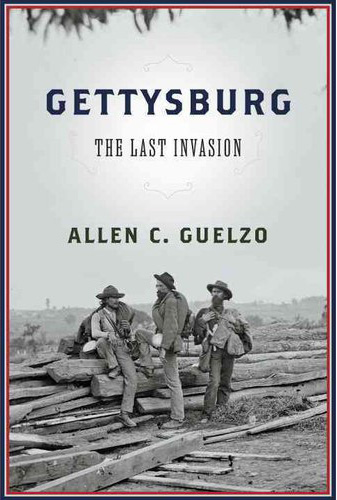
Gettysburg
The Last Invasion
By Allen C. Guelzo. 688 pp.
Knopf, 2013. $35.
Reviewed by Drew Lindsay
THE CONFEDERATES ARE ON THE MARCH, advancing toward Gettysburg and destiny. Soaring spirits lead to hijinks as the men reach a stone marker signaling their arrival in Pennsylvania. An impish soldier links arms with his commanding officer and together they step across the state line, launching what they call the invasion of the United States.
This anecdote is one of hundreds of gems in Allen Guelzo’s Gettysburg: The Last Invasion, a stylish, comprehensive, and entertaining narrative. His focus is the battle as a military event and the men who fought—a welcome perspective today, when the Steven Spielberg–driven fascination with Abraham Lincoln has turned the dramatic fight into merely a scene-setter for the president’s landmark speech.
Guelzo reminds us that this little Pennsylvania town is where two great armies met “in the greatest and most violent collision the North American continent had ever seen.” His account is not a typical tick-tock of troop movements; the pages are soaked in rich language and vivid character studies. When the Confederates camp in the Cumberland Valley, the land at night becomes “pinpricked with a carpet of fire lights.” Confederate lieutenant general James Longstreet has “pig’s eyes, vigilant and inspecting.” Union major general Joe Hooker is a “loud-mouthed bruiser…who projected a confidence which he did not, in the hollow core of his personality, really have.”
At nearly 700 pages, the book is packed, but it’s not dense. Guelzo knows the power of the telling detail. To illustrate how ill prepared the nation was for war, he plucks line items from the 1857 federal budget that in hindsight seem almost ludicrous—that Congress earmarked more for federal judges than it did for “armories, arsenals, and munitions of war,” and spent more on Washington’s Post Office Building than on West Point.
Interestingly, he rejects the common notion that the Civil War represents the first modern war. “It is difficult,” he writes, “to understand the ‘modernity’ of a war fought with single-shot muzzle-loading weapons, under the direction of commanders whose chief credential was a diploma from a military engineering school.”
The heart of Gettysburg is the average soldier. In his research, Guelzo leaned heavily on the diaries, memoirs, letters, speeches, and other accounts by the war’s veterans. No single voice dominates—there’s a cast of thousands, it seems—but the perspective makes timeworn elements of the story feel fresh.
Those who fought at Gettysburg were hardly up to the task. They were, as Guelzo notes, a bunch of volunteers “long on self-esteem and very short on experience”; their officers knew little of war and commanded with “small-town incompetence.”
“What ran up the Civil War’s enormous casualty lists was not expert marksmanship or highly refined weapons,” he writes, “but the inability of poorly trained officers to get their poorly trained volunteers to charge forward and send the enemy flying before the bayonet, instead of standing up and blazing away for an hour or two in close-range firefights where the sheer volume of lead in the air killed enough people to be noticed.”
At its core, Guelzo’s book explains some of the romanticism that hangs over the Civil War. Its soldiers appeal to us because they were ordinary people in extraordinary times; they fought with an appealing “amateurism of spirit and an innocence of intent,” as Guelzo puts it. But tragically, those same qualities ensured a bloody outcome, no matter who emerged the victor.





